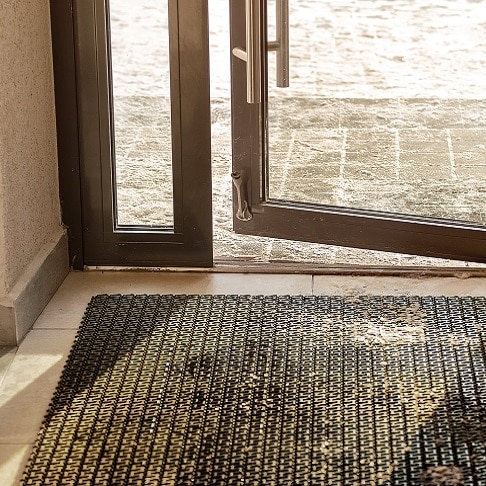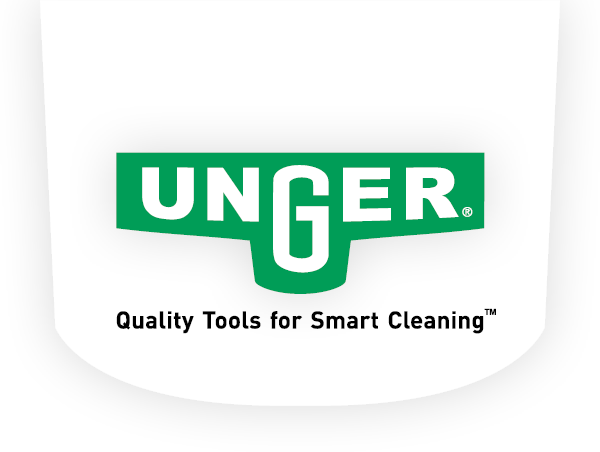NEW! Powerful Nano Filtration with Unger's HydroPower® Nano See The Product

4 Winter Cleaning Best Practices to Keep Facilities Cleaner and Safer
With inclement weather comes the snow, slush, dirt and white rock salt residue that transfers to floors and carpets once your patrons enter a facility. Bringing the outdoors in creates hard to remove residue on the floors and any other areas, not to mention a slippery mess. Add these circumstances to everyday routine cleaning tasks, and custodial staff have a taxing workload to contend with.
To help decrease cleaning times, while also providing the level of clean necessary to keep a facility safe and clean, having your winter cleaning best practices established and the right commercial cleaning equipment on hand can successfully plow you through the winter season.
Best Practice #1: Start with the Exterior
Ensuring a clean outside area is your first line of defense in protecting the appearance and safety of your entryways. Up to 80% of contaminants come into buildings on the soles of shoes. As such, it’s important to stop as many contaminants as possible in their tracks before entering the building.
Regular inspection and maintenance of parking lots and sidewalks that lead to the entrance(s) of the facility are essential. Freezing rain, snowfall and sleet can lead to water tracked throughout the building, increasing vulnerabilities to slip and fall accidents in the workplace.
Tips to stop the spread of contaminants before they enter your building:
- Ensure your outside lighting is functioning well. If people can’t see ice or snow on the ground, it may increase the likelihood of injury. And if your cleaning staff can’t see it, they cannot remove it.The use of a long handled light bulb changer will keep feet on the ground and off dangerous ladders and lifts while changing lightbulbs quickly and easily.
- Keep sidewalks and walkways clear of wintry mix and debris. A heavy duty squeegee will easily remove water and debris from a multitude of surfaces. A squeegee like the Unger AquaDozer Max offers a unique curved blade and durable steel body for tough demands like snow and slush removal.
- Invest in commercial floor matsfor your building exteriors. Snow melting mats are especially popular for commercial structures and require less monitoring. Scraper mats provide patrons with a simple way to remove dirt, ice, and snow from their shoes before entering the facility.
- Mat placement is also essential. Ensure that people can’t walk around them. Cleaner shoes and boots will ultimately result in a safer work environment and lower germ transmission. 85% of dirtwon’t get past the entryway if mats are appropriately selected, placed, and maintained.
Best Practice #2: Protect Your Windows
Although not a popular time to be outside working, maintaining windows is important during the winter as they are vulnerable to weather elements. Dirt, snow, ice, and road salt can build up on windows and over time, harm the glass itself, frame, and casing. For this reason, cleaning outdoor windows during the winter months may be necessary, though there are some modifications to consider.
To keep the water on the glass from frosting over or freezing, the window washer needs to increase the speed of cleaning. One solution is to select an appropriate size glass squeegee that can clean the window in the least amount of strokes. Normally for window cleaners time equals money, but in colder temperatures, time equals frost.
The window cleaner may also need to adjust the window cleaning technique as well, dividing larger windows in smaller sections to limit the risk of the water freezing on the window before the squeegee reaches the bottom.
It is still possible to use a waterfed window cleaning pole in the winter to reach higher windows, but with that comes additional considerations. On important consideration is the hose from the water source and the hose on the pole itself. If either hose goes too long without water running through it, the static water can freeze quickly, so outside temperature is key.
Best Practice #3: Preserve Your Floors
As snow melts, it deposits salty liquid, which flows into the microscopic scratches and holes in your floor’s finish and the salt can also dull the appearance of hard floors, making snow a nightmare for preserving floors. Cleaning floors regularly to remove water and debris will help avoid less effective cleaning or in the worst case, a flooring replacement after winter passes.
Combining an increase in floor mopping in high traffic areas such as entryways and lobbies is no small feat given the foot traffic in these common areas. To ensure an effective clean while keeping passing by patrons safe from slippery floors, you’ll need a floor mopping system designed for fast and effective cleaning.
Using a dual bucket floor mopping system instead a traditional single chamber mop bucket you can conserve water during the cleaning process. When you use high-quality microfiber mops and a dual-system mop bucket, you don’t use as much water in your cleaning solution to clean a large area. Consequently, you minimize slip and fall accidents because you use less water in your solution and an absorbent mop removes the remaining water from the floor.
The same all-in-one system – dual chamber bucket, microfiber mop, onboard wringer and scrubber – also allows cleaning staff to get the job done faster as they will spend less time refilling buckets and drying floors.
Best Practice #4: Limit Virus Transmission
During the colder winter months, the spread of colds and flu can lead to widespread absenteeism and, as a result, reducing employee productivity and increasing absenteeism. In fact, the U.S. Bureau of Labor Statistics found that 7.8 million workers had an illness-related work absence in January 2022 alone which is up from 3.7 million in January 2021.
For cleaning professionals and facility managers the winter challenge includes increasing efforts to protect patron health and limit virus transmission, and certain commercial cleaning tools will support this goal better than others.
Microfiber cleaning cloths are an effective solution for cleaning high touch areas, such as handles, faucets, knobs, etc. In an independent study conducted by the Environmental Protection Agency (EPA), the EPA found that extremely fine (.37 micrometer diameter) microfiber was both laboratory and clinically tested and proven to remove up to 98 percent of bacteria and 93 percent of viruses from a surface using only water (no chemicals).
A distinct color-coding system for professional cleaning tools – including microfiber cloths – allows facility managers and workers the ability to organize equipment and prevent cross-contamination when cleaning between work zones (example: using restroom mops in restroom areas only, not in public/food prep areas). Distinct color-coding makes it easy to separate tools into their correct areas of use or cleaning task reducing bacteria cross-contamination between areas. The results are better sanitation and cleaner facilities.
Cleaner, Safer and Faster Cleaning Throughout the Seasons
Every season brings its challenges and when combined with the unique footprint of every facility, can be challenging to address through routine cleaning practices. However, with the right commercial cleaning equipment, cleaning professionals and facility managers can be sufficiently prepared for any challenge without sacrificing the speed, efficiency or safety in which the tasks at hand are performed.
Contact us today for guidance on selecting the right professional cleaning tools for winter cleaning needs.

